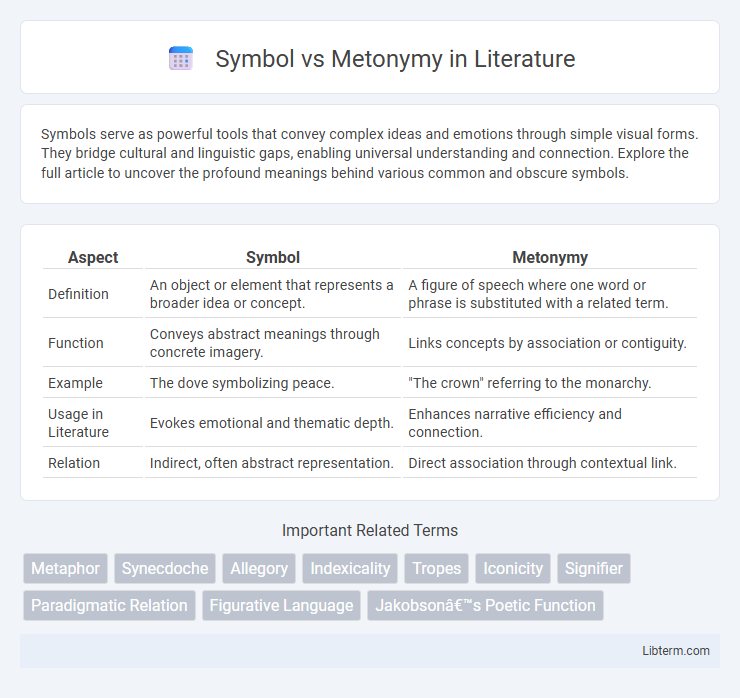Symbols serve as powerful tools that convey complex ideas and emotions through simple visual forms. They bridge cultural and linguistic gaps, enabling universal understanding and connection. Explore the full article to uncover the profound meanings behind various common and obscure symbols.
Table of Comparison
| Aspect | Symbol | Metonymy |
|---|---|---|
| Definition | An object or element that represents a broader idea or concept. | A figure of speech where one word or phrase is substituted with a related term. |
| Function | Conveys abstract meanings through concrete imagery. | Links concepts by association or contiguity. |
| Example | The dove symbolizing peace. | "The crown" referring to the monarchy. |
| Usage in Literature | Evokes emotional and thematic depth. | Enhances narrative efficiency and connection. |
| Relation | Indirect, often abstract representation. | Direct association through contextual link. |
Understanding Symbol and Metonymy
Symbol represents an object, action, or idea that stands for something beyond its literal meaning, often rooted in cultural or emotional significance. Metonymy involves substituting a related term or attribute to represent the whole, such as "the crown" for royalty, emphasizing a direct association. Understanding these concepts enhances interpretation in literature, communication, and semiotics by distinguishing between abstract representation and concrete relational substitution.
Defining Symbol: Meaning and Use
A symbol represents an abstract concept or idea through a tangible object, image, or sign that conveys deeper meaning beyond its literal sense. In literature and communication, symbols enable complex ideas and emotions to be expressed succinctly, often invoking cultural or contextual associations. Unlike metonymy, which substitutes a related object or attribute, symbols rely on established or culturally understood connections to represent broader themes or concepts.
What is Metonymy?
Metonymy is a figure of speech where a related term or attribute substitutes for the object or concept it is closely associated with, such as using "the crown" to represent royalty or "the White House" to denote the U.S. president or administration. Unlike symbols that represent ideas through broader abstract connections, metonymy relies on direct, often physical or contextual relationships to convey meaning. This linguistic device enhances communication by enabling more vivid, concise, and contextually rich references within language and literature.
Key Differences: Symbol vs Metonymy
Symbols represent ideas or concepts through an object or image that stands for something beyond its literal meaning, such as a dove symbolizing peace. Metonymy involves substituting a word with another closely related term, like using "the crown" to refer to royal authority. The key difference lies in symbols embodying abstract meanings, while metonymy relies on association or contiguity between the terms.
Historical Origins of Symbol and Metonymy
Symbol and metonymy have distinct historical origins rooted in linguistic and semiotic traditions. Symbols trace back to ancient civilizations, where abstract representations like hieroglyphics and religious iconography conveyed complex ideas beyond their literal form. Metonymy originates from classical rhetoric, notably in Greek and Roman literature, where it served as a figure of speech linking related concepts through contiguity, such as "the crown" representing monarchy.
Role of Symbol in Literature and Art
Symbols in literature and art serve as powerful tools to convey abstract ideas, emotions, and themes through tangible objects or imagery, often enriching the narrative and inviting deeper interpretation. Unlike metonymy, which replaces a concept with a closely related attribute or association, symbols evoke universal meanings that transcend their immediate context, fostering a more profound connection between the creator and audience. The role of symbols is pivotal in shaping cultural significance and emotional resonance within literary and artistic works.
Metonymy in Everyday Language
Metonymy is a cognitive linguistic process where a concept or object is represented by something closely associated with it, such as using "the crown" to refer to royalty. In everyday language, metonymy facilitates efficient communication by leveraging familiar associations, like "Hollywood" meaning the American film industry or "the White House" symbolizing the U.S. executive branch. This use of metonymy allows speakers to convey complex ideas succinctly, enhancing understanding and cultural relevance.
Examples of Symbol and Metonymy
A symbol represents an abstract idea or concept through a tangible object or image, such as a dove symbolizing peace or a heart symbolizing love. Metonymy involves substituting a related term for the concept itself, exemplified by using "the crown" to refer to royal authority or "Hollywood" to denote the American film industry. These linguistic devices enrich communication by embedding complex meanings into simple, recognizable elements.
How to Identify Symbol and Metonymy in Texts
Identify symbols in texts by recognizing objects, characters, or events that represent abstract ideas beyond their literal meaning, such as a dove symbolizing peace. Metonymy can be detected when a related concept or attribute is used to stand in for something it is closely associated with, like using "the crown" to refer to royalty or authority. Analyzing the context and relationship between terms helps distinguish whether an element functions as a symbol or metonymy within the narrative.
Importance of Symbol and Metonymy in Communication
Symbols enable abstract ideas to be conveyed succinctly, enriching communication by allowing listeners to grasp complex meanings beyond literal interpretation. Metonymy enhances clarity and efficiency by substituting related terms, facilitating faster understanding through familiar associations. Both devices are essential in language, art, and media, deepening expression and streamlining the transfer of cultural and contextual knowledge.
Symbol Infographic

 libterm.com
libterm.com